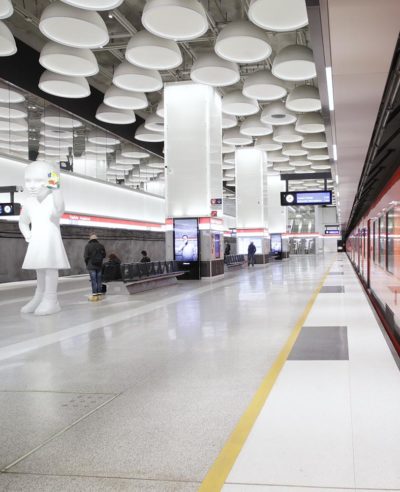In an environmental statement on the Matinkylä–Kivenlahti project, Länsimetro has determined the environmental impacts of the excavation and construction of the metro tunnels and five metro stations (Finnoo, Kaitaa, Soukka, Espoonlahti, Kivenlahti), as well as the Sammalvuori depot, in 2014–2019.
To assess environmental impacts, we monitor the impacts of construction on the groundwater, ground settling, water level and soil, and we monitor water consumption and wastewater processing during construction, taking biodiversity into account and paying attention to dust and noise caused by the work sites.
The excavation contracts started up in 2014 and ended in 2018. Construction of the metro continued with construction contracts covering the stations and the rail tunnel, and these will continue until 2023.
The following is reported on in the environmental statement covering the 2014–2019 excavation and construction phase:
- Consumption of main materials: explosives, chemicals, fuels, concrete
- Energy consumption
- Carbon footprint
- Generation and utilisation of aggregates
- Generation and processing of waste
- Impacts on groundwater, ground settling, water level and soil
- Water consumption and wastewater
- Biodiversity
- Dust
- Noise
- Stakeholders and dialogue, feedback, environmental requirements
As the developer, Länsimetro encourages material efficiency
Länsimetro, as the developer, can have an influence by encouraging contractors to be efficient in their use of materials. Material efficiency in construction saves natural resources and reduces waste, in turn, also mitigating the construction site’s carbon dioxide emissions. Some examples are using data modelling when designing the station and careful planning of the work phases and material purchases, which helps avoid ordering excess materials and storing them on the work site.
Construction volumes are reflected in, for instance, the number of rock-reinforcing bolts used during the excavation phase. Tunnels are reinforced at the stations using roughly six-metre-long bolts that are drilled into the rock. Based on the excavation contractors’ information, an average of 100 km of rock-reinforcing bolts were installed in the stations per excavation contract. With the average length of one bolt being six metres, the total length corresponds roughly to the distance between Helsinki’s main railway station and Hämeenlinna’s city centre.
The environmental statement also contains an assessment of the environmental impacts of blast-rock haulage. The total haulage distance for all the two-way haulages in the station and tunnel excavation contracts amounts to approximately 10,664,900 kilometres. This is the equivalent of around 267 times around the world.
72% of the carbon footprint comes from construction materials
The environmental statement also reveals that by the end of 2019, the majority (72%) of the carbon footprint of the entire Matinkylä–Kivenlahti project was made up of materials, followed by rock-blast and waste haulage (13%) and fuels (9%). By the end of 2019, roughly half of the entire project’s carbon footprint arose during the excavation phase and half during the construction phase. The total carbon dioxide emissions from excavation and construction amounted to 90,800 tCO2 by the end of 2019.
Groundwater monitored, flying squirrels taken into account
The findings of the environmental statement also indicate that the project’s construction work has had no noticeable impact on the quality of water in the groundwater pipes. In many places, the changes in the ground-settling monitoring points of buildings remained below the measurement inaccuracy. No changes deviating from the natural situation have been observed in the water level of Hannusjärvi Lake.
Near the rail line, the Finnoo area, the Kaitaa area and the Espoonlahti–Soukka area have been identified as core flying squirrel habitat areas. The core flying squirrel areas have been taken into account in the metro station planning, and flying squirrel habitats have not been endangered. The area’s metro shafts have been situated to cause as little disturbance as possible to flying squirrel habitats. The main routes of flying squirrels, i.e. treetop connections, have been retained.
Stakeholders a key part of the project
Stakeholder work has been and continues to be an important part of the Matinkylä–Kivenlahti project. The most important stakeholders from an environmental sustainability perspective are the construction area’s nearby residents, businesses and other operators, builders, policy-makers and the owner, the authorities and the personnel working on the project.
Feedback on the Matinkylä–Kivenlahti project can be given by phone or via the feedback form on the website. All feedback is addressed and responded to. Measures have been taken based on the feedback, for instance, possible damage has been investigated, the cleaning of work-site roads has been stepped up, and direction has been given to work-site operations as required based on noise complaints.
The environmental statement will be updated in 2020–2023.
Read the environmental statement (in Finnish, PDF )
Further information:
Kati Vesikallio, Environmental Manager, email kati.vesikallio(at)lansimetro.fi



